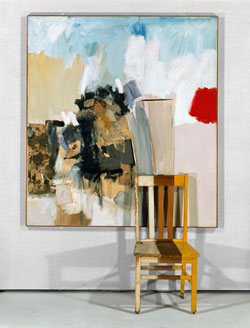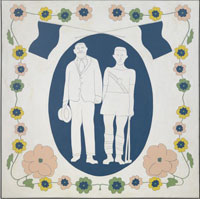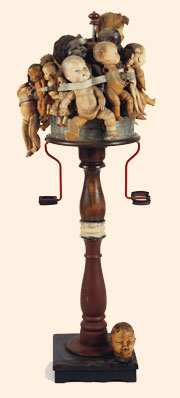Hauser & Wirth shows fine works from the Onnasch collection

Simply sign up to the Life & Arts myFT Digest -- delivered directly to your inbox.
When a global gallery devotes the lucrative winter season in all three of its London spaces to a non-selling show of historic 20th-century art, it is making a statement. Such a display speaks, on the surface, of wealth so great that a dealer does not need to trade, of scholarly confidence aspiring to that of a museum, of curatorial vision and impeccable connections.
Until December, Hauser & Wirth’s Re-View: Onnasch Collection showcases 80 works from the holdings of a Berlin dealer celebrated for his reluctance, or inability, to sell. Reinhard Onnasch was the first postwar German gallerist to go to New York; he opened there with Gerhard Richter and sold not a thing. He was more successful with traffic the other way – he introduced German audiences to Jim Dine, Claes Oldenburg and Robert Rauschenberg but he was still better at keeping things than parting with them; as he said in a rare German interview in 2010: “Once you get your hands on a Barnett Newman masterpiece, you never let it go.”
The result is a collection varied and distinguished enough to illustrate the complex overlapping narratives of American art from the 1950s-80s – decades when New York was at the zenith of its cultural influence – yet also personal and surprising.
Like competitive though friendly siblings, each Hauser gallery charts a separate trajectory. The North Gallery on Savile Row opens with the slangy monumentality of Franz Kline’s “Zinc Door” – an architecture of dynamic black lines, thick as steel bars, offset by light, feathery marks – opposite an Ad Reinhardt black monochrome and a pair of Clyfford Still abstractions of impasto, saturated colour, insistently vertical with paint dripping into ragged ends like stalactites. Still, distrustful of the market, sold only 100 paintings in his lifetime, 10 of them to Onnasch; after his death in 1980, the rest of his oeuvre was sealed off completely until the Clyfford Still Museum opened in Denver in 2011.
Dialogue between the North Gallery paintings fizzes. The Stills, dating from the early 1950s when he had just arrived in New York from California, look forward to the Color Field movement as exemplified here by Morris Louis’s four-metre “Unfurled” paintings, exuberantly framed with streams of pure unmixed paint. Kenneth Noland’s geometric abstractions, “Wotan” and “Sunrise”, in turn adopt Louis’s direct application of colour. Quietly in a corner, Cy Twombly’s “Leda and the Swan” – how bizarre it must have looked in this company in 1960 – fuses drawing and painting in sketchy, erotic doodles, impermanent, fragmentary, denying the idea of a finished art work, looking forward to minimalism and conceptualism, and – you see with hindsight – to Twombly’s late, extravagantly sensuous paintings.

Next door at the South Gallery, a display full of wit and interest traces how Oldenburg and Jim Dine pay homage to the painterliness of the New York School while embracing pop’s delight in consumer culture and everyday life. Dine embeds chisel, hammer, pliers into monochrome canvases. Oldenburg paints in latex on plywood and Masonite to create the giant fantastical “Model for a Mahogany Plug”, and in enamel over muslin soaked in plaster for the saturated pink/white sculptural “Two Girls’ Dresses”. The star here is Rauschenberg’s combine “Pilgrim”: a vehement gestural painting in blue and white is layered with paper and fabric collage in sweeping strokes that culminate in a kitchen chair, looking as if it has slipped down the canvas, inviting the viewer to enter the painting.
Up the road at the formal Piccadilly Gallery, a difficult space, the tricky aesthetic of assemblage is explored more fully, with an emphasis on Ed Kienholz’s political works such as “The Future of an Afterthought”, a cluster of baby dolls grouped into the silhouette of a mushroom cloud.
Throughout, vitality and inventiveness, and also the pleasures of antagonism and contrast, course through the displays, with dominant trends interestingly nuanced by works on the fringes of the canon. Candy-coloured cartoonish paintings by John Wesley and William Copley – “Olympic Field Hockey Officials”, “Give me that piece of chalk with which you mark the baseball score” – are an unexpected take on Pop. The intricate tableau-like boxes and bell jars, stuffed with doll’s house furniture (“Monument to the Revolution”) or coloured balls (“Perfectionne Extra Superior”) by George Brecht, né George MacDiarmid, a German-infatuated American conceptualist, chemist and composer, illustrate the obsessional quality of assemblage.

Onnasch’s open, quirky taste makes him a natural poster boy for Hauser & Wirth, most European in outlook of London’s major galleries and one that consistently seeks to walk the tightrope between high-end sales and anarchic spirit. Onnasch, for his part, gets top-flight presentation: the show is curated with flair by Hauser & Wirth’s new partner Paul Schimmel, formerly of the Museum of Contemporary Art, Los Angeles.
Schimmel, who will establish Hauser, Wirth & Schimmel Los Angeles and present more museum-quality shows, accepted the offer from Hauser in preference to a more lucrative one from Larry Gagosian, who last year snapped up John Elderfield, former Museum of Modern Art chief curator. Following his landmark de Kooning retrospective at MoMA in 2011-12, this autumn Elderfield curates late de Kooning for Gagosian.
But no commercial gallery exhibition is entirely philanthropic. The Onnasch display, showcasing works that prefigure a particular vein of intellectual/playful late-20th-century conceptualism, subtly boosts the historical position of many Hauser artists – Martin Creed, Paul McCarthy, Christoph Buchel, Phyllida Barlow, Isa Genzken, among others – helped by the erudite imprimatur of Schimmel. For Gagosian, Elderfield lends similar prestige to late de Kooning, which remains controversial.
What’s not to like? Audiences get great free shows, curators are released from bureaucratic bondage, museums are kept on their toes. Yet increasing slippage in identity between private and public gallery comes at a familiar 21st-century price: it strengthens the market at the cost of art-historical objectivity. The works may not be for sale or profit but the ideas are.
‘Re-View: Onnasch Collection’, Hauser & Wirth London, to December 14 hauserwirth.com
Comments